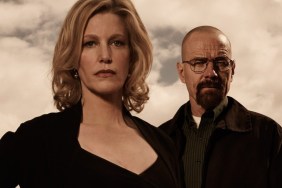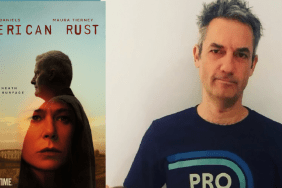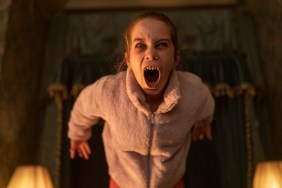Although we recently chatted with the film’s director, Kevin Macdonald, and star, Saoirse Ronan, ComingSoon.net had the opportunity to catch up with How I Live Now‘s director of photography, Franz Lustig, at the month’s Camerimage Festival of the Art of Cinematography in Bydgoszcz, Poland. Set in the immediate future, the film takes a look at the outbreak of World War III, as told through the eyes of an American teen sent to live with relatives in Europe. You can check out Lustig’s thoughts on constructing the look of the dramatic anti-war film in the interview below.
If you missed them, be sure to check out our previous Camerimage interviews here and look for more in the days to come.
CS: How are you enjoying Camerimage so far?
Franz Lustig: Oh, I’m very happy. I’m watching so many movies and I’m in great company with all these masters. I think you never stop learning, so it’s great to have discussions about films with these guys. You hear all the old stories and it’s really, really great. I’m enjoying it.
CS: How did you meet Kevin Macdonald for the first time?
Lustig: Kevin and I met during a commercial. I do a lot of commercials. I haven’t done a feature for five years because I became a father and I wanted to spend more time at home. When I met Kevin the year before “How I Live Now,” it was kind of a documentary style commercial for UBS for a bank. It was this racecar driver Maria Teresa de Filippis. She’s 85 or something. Really old. She’s the only female racer from the ’30s, I think it was. She’s really famous with Ferrari. We got this three million dollar car and she’s racing it on one side and we’re trying to chase her with a Russian arm and doing other visuals and interviews. It was also a mixed format thing. We did Alexa and 35 and it turned out to be a really nice experience and a lovely day with Kevin. Obviously, when you meet somebody like Kevin, who I admire for his work, it’s always exciting how you click. There’s one thing with the work where it’s about what you can do technically, but there’s something else altogether in the chemistry. I think that worked pretty well from the start. When he came the February after to the Berlin Film Festival’s world premiere of “Marley.” Luckily I was there and we had dinner and he offered me “How I Live Now.”
CS: What was your personal vision for the film?
Lustig: “How I Live Now” is an anti-war film for teenagers and I’m always seeking for a message in the feature work I do. I want to leave something. Besides entertaining people, I want to leave something that makes sense. For me, a feature is like a tattoo. You can’t wipe it off. It stays, so I make my decisions quite profoundly. That might seem a bit picky for some people, but I take the liberty and the luxury to only do the features that I really want to do at any particular moment of my own life and where I’m at. Then I can be good and it’s not a job. I don’t see it as a job. Commercials are something different. You sell a product. To balance that out, there has to be something more. I had read the novel of “How I Live Now.” It’s a fabulous book and a work of young adult literature that should be read by all school kids, I think. It really condemns war, but also tells you a love story. It’s very approachable for teenagers. In the end, we had to hit that mix of romantic teenage love story and a grim journey in war times. Some people don’t get that together, but we just decided to do it that way and make two different parts. Have the one world end and have the new, grim world start. When I read it, I thought, “How the hell do we do this with little kids?” They tried for eight years to get the film going and couldn’t lift it off the ground. Many components came together. First, Sersh [Ronan] is amazing. She’s perfect for the role. She’s 18, but she looks like 16 so you can do certain scenes and things schedule-wise with her that you couldn’t do with a 16-year old. That extends your budget or your shooting time. Then it’s the same with the eight-year old, Harley [Bird], who has never acted in live-action. She’s the voice of “Peppa Pig” and won a BAFTA for that, but she never actually was acting. You didn’t know how she would react. To have all these kids playing these parts and scheduling them with night shoots and complicated weather situations, I think they were not scared, but they just couldn’t do it for some reason. When I jumped on and Kevin and Sersh and everything came together, it was just one of those moments where you have all the components and then you can do a film. It was tricky, though, and I found all kinds of ways to move really quickly and fast with this young cast. We didn’t expect the little one to last a whole day and be able to repeat scenes and continuity. You can’t expect something like that. We had to be really flexible and, really, it felt sometimes like a documentary film, but with actors. We were changing the angle in the room all the time and covering really quickly with a handheld Alexa M with a 20-60 zoom, handheld on the Easyrig. It was super-fast. Even if you step into a closeup and it wasn’t exactly right, you could adjust it on the zoom, which I love. I love when I get a real moment from a young actress that can’t be repeated. Its my job to get it.
CS: It’s a very interesting film from a cinematography perspective because a lot of the story is about what you don’t see as far as this war goes. Where you very conscious about how much and how little to show?
Lustig: Yeah, we were very conscious. I think it’s a good decision to do it that way because the other stuff has been seen and it’s kind of repetitive and it’s not needed, you know? If you want to show this world, you can just have it in the background. I think it enhances the world rather than distracts with big stuff. Sometimes, in certain scenes where it comes down to action, I think we were both — Kevin and I — were wishing for a little more money and possibilities to do it. Then it looks like, “Wow, they can do it,” and not that we didn’t do it because we didn’t have the money. We tried with our limited budget to do one scene and it was a hard struggle. The one scene with the truck where they have to leave the boy behind. That was just so tricky to do because we just wanted more time and money to do it properly rather than in an action-lite way. We did it the way we could and that’s what it is, you know? All the other stuff with the war around them, we shot scenes in the village that are not in the movie. The had a bit of a bigger scale. They got pulled out and we did another few days additional shooting two or three months into the edit. The plane crash scene, for example, and the rape scene was redone for some reasons. Daisy, in the story, was too distant, so we wanted to have this eye contact with the victim. It was really good that we did that because it makes the journey a little more grim and it explains the world around a little more. If that had missed, it would have been really distant and it might be a bit too boring. There needs to be a reason that they go home and all that. We were a little limited, but you have to make it work.
CS: There’s a very faint sense of science fiction in “How I Live Now,” given that it’s sort of an alternate reality present day.
Lustig: Yeah, that’s written in the novel, but it’s not really there. It could be anything. Because it’s so vague, you don’t really know who the terrorists are and what the political background is. It could just as well be Al Qaeda or whatever. Not that they would overrun England. If you think of it like that, there must have been some time passed that led to certain systems collapsing. But that’s the only in for science fiction other than that. As far as the costumes and the cars, there’s nothing really science fiction about it.
CS: It’s extremely grounded.
Lustig: As I think it should be because it actually doesn’t matter when it takes place. The message is the same: “War sucks, especially for kids.”
CS: What gets you excited for a project?
Lustig: I read the script for the first time, which the most important time, to decide if I can see a film and feel attachment to it right away. That’s when I decide. We have to share some of the language, the director and me. You somehow have to know what you can achieve with the money they have so you can look into the future and see if you can make it work or if you’re willing to make it work. What does it need, et cetera, et cetera. You know? I get excited when the story hooks me and there’s a message that makes sense.
CS: Do you know what’s next for you?
Lustig: Something completely different. It’s probably — knock-on-wood because we should have done the film this year already but it got pushed — an entertaining thing. A DreamWorks project with an English director [Ringan] Ledwidge called “Glimmer.” It’s kind of time-travel thing in the ’70s. Also again with young actors and little bit more money.










